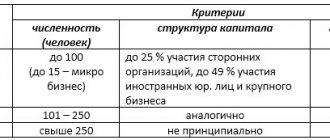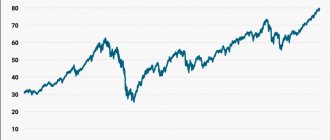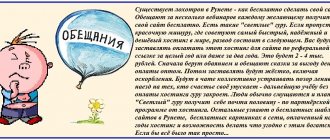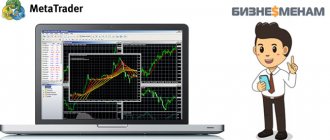Greetings, dear reader.
When we mention the words stock exchange, trading and investing, most of us get the impression that we are talking about something inaccessible. Actually this is not true!
Today I’ll tell you what Russian stock exchanges are and why they are needed. We’ll also talk about projects that have nothing to do with the stock market or investments. After reading the article to the end, you will be convinced that the principle of operation of exchanges is quite simple; everyone can invest in securities in Russia.
Brief history of appearance in Russia
In 1703, by decree of Peter 1, the first Russian stock exchange was organized in St. Petersburg. At first, trading was carried out exclusively on goods, but with the advent of securities, stock transactions began to be carried out on it.
By the beginning of the 20th century, there were 7 such sites in the Russian Empire. However, the communist regime did not provide for the existence of private property and a stock market. Therefore, with the advent of Soviet power, they were all liquidated.
The current stage of development of stock trading in Russia began in 1991. With the transition to a market economy, platforms for stock trading began to appear in different cities of Russia. Most of them have not been in operation for a long time, but those that began their work precisely then have also been preserved.
Who is a trustee and how to work with him?
A fiduciary manager is an organization to which you entrust the management of a package of securities according to a pre-agreed and approved strategy.
She must also have a special license from the Bank of Russia; you can check it in the Directory of Financial Market Participants.
So, you draw up a trust management agreement and discuss in advance a strategy for behavior on the stock exchange. For example, you want your investment portfolio to consist only of bonds of the largest and most reliable companies with stable income indicators - with an interest rate of at least 3%. You define these conditions, and based on them, the manager will decide when and what securities to buy and sell.
The advantage of trust management is that you do not need to constantly monitor the situation on the stock exchange; the trust manager does this for you. Moreover, your income will depend on his decisions, right or wrong. Therefore, it makes sense to understand how the stock market works in order to decide on a strategy.
List of the largest exchanges today
The activities of modern stock exchanges in Russia are regulated by the Federal Law “On Organized Trading”.
Moscow Exchange MICEX RTS
The Moscow Exchange was formed through the merger of the MICEX and the RTS, the largest exchanges in Russia in the early 2000s. The created holding immediately became the leader in the Russian Federation in terms of trading volume and has remained so for 8 years (RUB 58.9 trillion in January 2020). There is a wide range of financial instruments: stocks, bonds, futures, currencies and even grain.
St. Petersburg Exchange FBSPb
The site was founded on January 31, 1991, even before the collapse of the USSR. Today it is the oldest exchange in the Russian Federation. There are dozens of types of goods from various industries, as well as securities of foreign issuers.
For a long time, this platform was the only one in Russia where Gazprom shares were presented. All shares of the S&P500 index are listed on the FBSPb. In total, 742 securities are presented here (as of February 17, 2019).
Currency exchange in St. Petersburg
Unlike the previous platform, this exchange specializes in Russian financial instruments. There is active trading in securities, currencies and some other assets.
Moscow FB
In the early 2000s, the MFB was one of the leading Russian platforms. However, in 2013, it was reorganized, which resulted in a change in specialization. Today the company is engaged in providing clearing services, which was discussed above.
Siberian Interbank Currency Exchange SICEX
In the 1990s, SICEX was the leader in exchange trading in the eastern region of Russia. However, with the development of technology and the advent of Internet trading, the popularity of regional trading organizers began to decline. Now the site has turned into a branch of the Moscow Exchange and is promoting its services in Siberia.
Nizhny Novgorod Currency and Stock Exchange NVSE
Another regional center, the NVSE, suffered a similar fate. Since 2007, it has been called Regional Exchange CJSC. Its tasks include actions to attract customers (including through educational programs) and promoting the Moscow Exchange brand in the region.
Who is a broker and how to work with him?
A broker is an intermediary between an investor and an issuer, a professional market participant who makes transactions in securities for the investor.
Most often, the functions of intermediaries are performed by private brokerage companies and banks. To operate, they must have a special license issued by the Bank of Russia (until 2013 they were issued by the Federal Service for Financial Markets). You can check whether the broker you have chosen has a license in the Directory of Financial Market Participants.
You enter into a service agreement with a broker and open a brokerage account. The broker carries out operations on your instructions. The money for the purchase and the broker's commission are debited from the brokerage account - the fee for helping you complete a transaction on the stock exchange. In addition to the transactions that the broker will make, he calculates and withholds your income tax - 13%.
You can communicate with a broker via the Internet if you install a special program - a trading terminal. You can also give instructions over the phone; for this you will be given a special card with codes. The broker calls the cell number in the card, you erase the protective layer and name the combination of numbers printed in this cell.
When working with a broker, you need to independently develop an investment strategy. That is, only you will make decisions about what and when to buy and sell. The broker is not responsible for risks and transactions, he is just your “hands” on the securities market - he carries out your instructions. Therefore, you will need to thoroughly understand how the securities market works and constantly monitor the situation, analyze information and make decisions.
If you have little experience and are not confident in your decisions, you can find another professional intermediary who will help you decide which securities and when to buy and sell - a trustee.
Which exchange is the main one in the Russian Federation?
This status is not provided for at the legislative level. There are several stock trading platforms in Russia; each issuer has the right to choose where to place its securities.
The largest exchange in Russia today is the Moscow Exchange. Having absorbed regional sites, it was able to concentrate resources from all over the country.
The MICEX and RTS indices still remain the most important indicators of the Russian stock market.
Largest monetary organization
The most authoritative Russian currency exchange is the Moscow one. It existed from 1992 to 2011, until it merged with RTS.
From the very beginning, this structure had as its main specialization the holding of currency auctions, and subsequently there was also a place for a stock market on which Russian issuers conducted trading, the maximum capitalization of which at some points amounted to over 500 billion dollars.
The Moscow system at the time of its operation serves six markets, namely: futures, stock, commodity, over-the-counter, foreign exchange, money.
At the same time, the stock market of the exchange is further divided into three more segments:
- Main market.
- Standard.
- Classika.
The main market is precisely the segment that accounts for about 80% of all stock trading and over 99% of bond trading. This sector, strictly speaking, is the real center for generating liquidity for Russian securities, and is also considered the leading trading platform for foreign investment in shares of leading domestic companies.
The main Russian stock exchange also has a very active foreign exchange market, where there is access to trading in the United States dollar, Ukrainian hryvnia, euro, Belarusian ruble, Kazakh tenge, Chinese yuan, currency swaps and the bi-currency basket.
It is noteworthy that this exchange of Russian companies has become a place where many Russian commercial structures that previously worked on foreign trading platforms enter. For example, in March 2020, the largest builder in Moscow, the PIK group, decided to terminate its membership on the London Stock Exchange and become a trading participant on the MICEX-RTS. The company's management explained this decision by saying that this would increase the liquidity of their shares.
According to Tom O'Brien, head of international sales at the Moscow Exchange, the London trading platform is inferior to the Russian one because it has exclusively foreign money, while the capital of local and foreign companies is concentrated in Moscow.
Why are Russian stock exchanges needed?
The main function of Russian stock exchanges is to ensure the functioning of a civilized stock market on the territory of the Russian Federation. Sales and purchase transactions, along with private property, are the basis of a market economy. Russian stock exchanges allow you to make such transactions quickly and safely.
Their tasks include:
- Ensuring openness of trading in Russia and access to it for as many investors as possible.
- Determination of the equilibrium market price of traded securities. Based on the share price of any company, you can calculate its capitalization.
- Attracting free funds from the population and legal entities.
- Developing and monitoring compliance with ethical trading standards and ensuring transaction security.
What it is
What is a classic stock exchange of the 21st century? First of all, a stock exchange is a securities market, where the emphasis must be placed on the word “market”. As in any market, the stock exchange operates on the main criteria - supply and demand. Each price is a specific person. You have probably seen demand graphs for currency, precious metals or raw materials at least once in your life.
The stock exchange demonstrates how people's mood directly affects the price of securities.
Trading schedule on the Moscow Exchange.
Trading on the Moscow Exchange is carried out within strictly defined time periods. Trading sessions are replaced by clearing breaks accordingly, also according to the schedule, naturally, Moscow time.
- 10:00 – 14:00 – Beginning of the main trading section;
- 14:00 – 14:04 – Intermediate clearing break. Also, this session is called “day clearing”;
- 14:04 – 18:45 – End of the main (day) trading session;
- 18:45 – 19:00 – Evening clearing session;
- 19:00 – 23:50 – Evening trading session.
BREAKTHROUGH in your trading!
This information is superbly applied to trading using VSA methods. In fact, this information can make a breakthrough in your trading.
Make a breakthrough in trading!
Commodity market.
On this market of the Moscow Exchange, trading is organized with the conclusion of transactions in gold and silver. And in 2014, a project called “Grain Market” was launched. And already in December 2020, trading in delivery forwards for wheat began. And in 2020, the range of instruments available on the Moscow Exchange commodity market has expanded significantly to include sugar forwards!
Market of standardized derivatives.
Or the OTC market (over the counter - over-the-counter transaction) with a central counterparty (CCP). Was created for the G20* communiqué (notice, notification) adopted after the G20 meeting in Pittsburgh in 2009. Here at this meeting it was decided that standardized derivatives should be traded on an exchange.
*G20 – Big Twenty. Club of governments and heads of central banks of states with the most developed and steadily developing domestic economies. Thus, the G20 countries, including Russia, confirmed their intentions to strengthen the role of the central counterparty in the coming years. At the same time, in the short term, the Central Bank of Russia sees clearing with a central counterparty as mandatory!
How to trade the stock market
Let's look at the stages of trading on the stock market:
- Choosing a broker and opening a brokerage account. At this stage, you need to clarify which exchanges you will have access to and whether all the securities you want can be purchased. Pay attention to the entry threshold and fees. And don’t forget that Russian investors have a unique opportunity to reduce taxes and take advantage of special benefits. To do this, you need to open an IIS. There can be as many brokerage accounts as you like, but there is only one IIS.
- Refill. All major brokers provide the opportunity to deposit money through a bank account using the details or using a bank card.
- Installation of trading platforms. These can be professional platforms such as QUIK or brokers’ own developments in the form of applications for computers and smartphones, for example, “VTB My Investments”, FinamTrade, etc.
- Carrying out trading operations. If you doubt that you will independently understand the technology of buying and selling securities, take training. Brokers have free video tutorials on how to use the trading platform. I opened accounts with two brokers with zero knowledge of how and what works there. But I easily figured out the interface. Brokers try to make applications intuitive for all users.
At first, it will be interesting for you to log into your portfolio every day and watch the dynamics. But with long-term investing, this is a thankless and sometimes even harmful task. You can do emotional things. Therefore, I log into my personal account only when I make a purchase or sale of securities. And I always remember that my horizon is at least 10 years.
Heads of the Moscow Exchange.
2012 – 2020 – Chairman of the Board, head of the exchange Alexander Afanasyev. At the end of 2020, A. Afanasyev expects the approval of the new head of the exchange, Yuri Denisov.
2014 - At a meeting of shareholders, ex-Minister of Finance, Alexey Kudrin, was elected.
2016 - The Moscow Exchange Council expanded the composition of the board to 6 people. Thus, Anna Kuznetsova was elected to manage the stock market, and Igor Marich headed the money and derivatives markets.
2017 – Maxim Lapin became the Financial Director of the Moscow Exchange.











